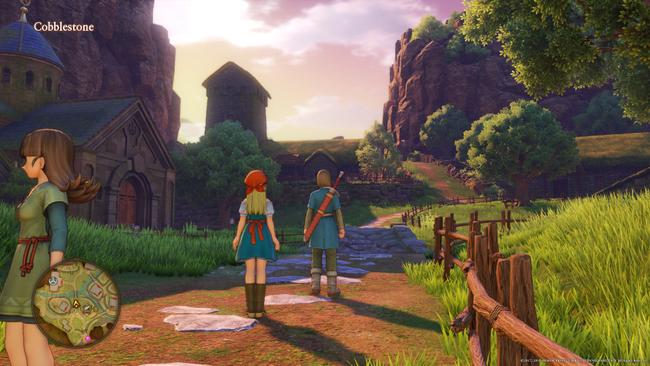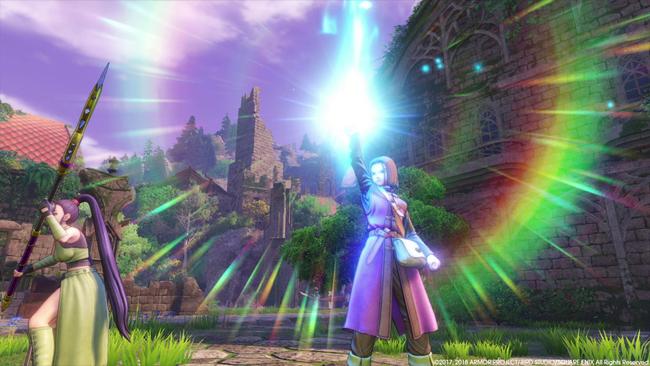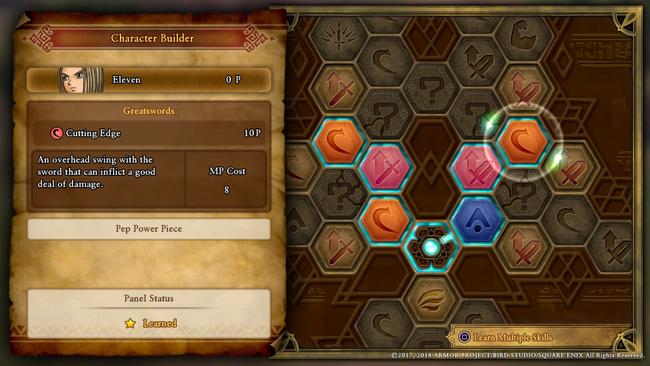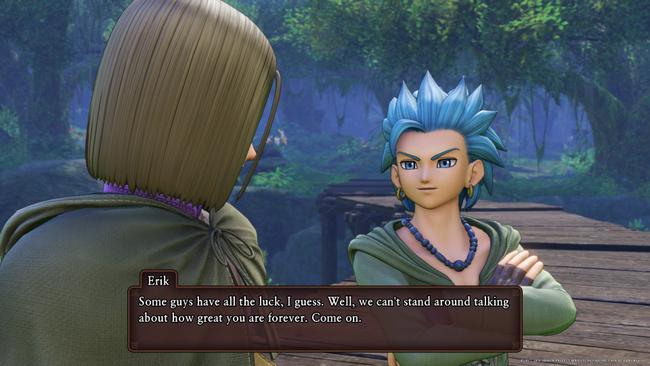
Dragon Quest XI: Echoes of an Elusive Age Review
It has been over nine years since the last mainline Dragon Quest game made its way Westward. Since Dragon Quest IX, we've missed out on the Japanese-only MMO entry Dragon Quest X, but in recent years there’s been a renewed sense of life in the franchise with titles like Dragon Quest Heroes and Dragon Quest Builders. While these spin-off titles still carry the spirit of the Dragon Quest series, they haven’t been the classic menu-based RPGs that the franchise is built upon. The wait is finally over, though, as Dragon Quest XI: Echoes of an Elusive Age is finally releasing on PlayStation 4 and PC… and for series veterans as well as newcomers to Dragon Quest, the wait was well worth it.

In Dragon Quest XI, you are the Luminary, the reincarnation of the legendary hero that saved the world in ages past. As such, it’s your duty to defend Eradea from the ancient evil that is set to reincarnate itself. In a classic tale of good and evil, you gather formidable fighters to your cause and set off on a journey to find the evil’s reincarnation and save the world.
Except, it’s ultimately a bit more multi-faceted than that. While the Dragon Quest series, in general, is not the most well-regarded specifically for its plotlines, XI manages to have not only an interesting narrative throughout but also one that throws several compelling and surprising twists along the way. As someone who hasn’t fully enjoyed a storyline in a Dragon Quest title since Dragon Quest V, I found myself completely engaged in the plot from start to finish here.
The story gives the Hero and other characters proper and fascinating motivations, and these motives become more and more intricate as events unfold in the latter portions of the game. As the plot begins to shift from a 'saving-the-world' theme to a more personal tone focused on the party and the other denizens of Eradea, DQXI's narrative begins to shines the most, and it ultimately makes for one of the more memorable tales in the series. It's hard to say more without giving too much away, but for those who look to RPGs for captivating storylines, Dragon Quest XI deserves your attention.
Additionally, most of the story beats hit players well due to Dragon Quest XI’s overall visual presentation. For starters, the game is downright beautiful. The art style is similar to Dragon Quest VIII, but the new HD offering absolutely shines on PlayStation 4. The world is meticulously designed, giving the player colorful landscapes to explore while traveling the world. Characters animations are fluid and both friend and foe are full of life, offering a high level of detail to every encounter. Square Enix is definitely using every developer technique at their disposal to make DQXI run beautifully on the console. I rarely ran into any noticeable slowdown during my adventure, even when enemies and allies were throwing around their flashiest moves.

The localization is also top-notch here. This may not come as a surprise, as most of the recently localized Dragon Quest titles have great localization efforts that give their games life and flair - and that tradition continues in XI. This is also backed up by overall great English voice acting, and a lot of the most important scenes have full voice acting to boot.
However, having a great story can be meaningless for an RPG if it's not backed up by its gameplay. My initial playthrough of Dragon Quest XI took me about 50 hours to get through, and that’s not including the truly extensive post-game content. Throughout its life, the Dragon Quest series has always been known to stick to a traditional gameplay style - perhaps to its detriment at times - resisting to move much beyond its tried-and-true classic mechanics. Dragon Quest XI manages to maintain its series' identity, retaining elements of an old-school style while still modernizing in a few places where needed to keep everything fresh.
For starters, this is still a menu-based RPG through and through, but encounters are no longer randomized as you can see your foes on the field, as seen in the 3DS remakes of Dragon Quest VII and Dragon Quest VIII. While there are two options for movement and the camera available during combat, this is for presentation purposes only and doesn't practically affect battles. It doesn’t matter if your characters stand in a row or are manually spread across the battlefield, positioning is just for show and any AOE moves will hit the same characters regardless.

Battles play out similarly like most classic RPGs. To make a small distinction here, previous Dragon Quest games played out in 'rounds' - where the player chooses all your party actions at the onset of the round. In Dragon Quest XI, however, you tackle enemies in a fully turn-based system, slinging spells and slashing up foes with individual character actions chosen independently from each other. While there is no method to speed up battles like in Dragon Quest VIII on Nintendo 3DS, encounters tend to proceed at a delightfully brisk pace, with the ability for certain animations to be skipped.
In Dragon Quest VIII, players were able to build up a 'tension' meter in combat, which strengthened the potency of various abilities and could even make your characters go 'Super Saiyan' for an extremely powerful attack. In Dragon Quest XI, tension is replaced with a more spontaneous 'pep' mechanic. You can’t choose to build up pep like you do tension (at least, not until you unlock some late- and post-game skills), it instead activates semi-randomly after characters take and deal out damage. Pep is also a multi-turn affair, where characters get stat boosts that play to each party members’ strengths and gain access to special powerful moves called Pep Powers.
Pep Powers consume the power of pep for one or more party members in order to unleash a devastating blow to your foes, but it also exhausts the stat bonuses that pep offers. So, it’s may not always be in players the best interest to use Pep Powers immediately and instead continue battling with the stat-boost in place. The pep system is a neat little wrinkle that adds just enough spice to the traditional combat style. It makes combat feel more dynamic while retaining the classic turn-based approach. It's also worth noting that if you manage to finish a battle with a character in a pepped-up state, they’ll retain their pep for the next battle until it eventually runs out.

Personally, tension was not one of my favorite mechanics from previous Dragon Quest titles. I found it was somewhat tedious to utilize effectively, essentially coercing me to waste multiple turns to tense a party member up while a boss can easily cancel all of that hard work out. Pep is a fantastic replacement to the old mechanic, giving pepped up characters multiple uses and with no requirement to dump turns pepping someone up first. Pep helps in regular battles and bosses alike, helping to turn the tides of difficult battles to your favor.
Eventually, you’ll fight through enough slimes to level-up. When you do hear that iconic level-up theme, you’ll gain skill points to learn new abilities and get stat boosts. The skills sets you can invest points are unique to each character, as each one has a few weapons they can master as well as one or two sets of skills that they can utilize.
For those that have played Dragon Quest VIII or Dragon Quest IX, this will all sound familiar. However in XI, instead of just dumping points into various skill sets, you instead spend these on a skills panel to gain new abilities. These skill grids show various abilities you can unlock for your characters, and each character's grid is independent from the rest. As you spend points on a node to activate it, the nodes around it become visible for you to see what bonuses they offer. This way, most of the available skill panels are visible by the second half of the game. Coupled with a relatively inexpensive way to reset skill points, you’ll be able to simply yet flexibly experiment with your party’s skill sets, crafting characters that best match your playstyle. There's just enough customization and choice available to the player to adjust their party setup without ever feeling too overwhelming.

New boss tactics and balancing also help to promote various playstyles. In past games, later bosses would often be quick to use skills that cancel out buffs and debuffs, sometimes making battles a bit more attritive than might be enjoyable. Such moves are far less common now, making abilities like Kabuff and Magic Barrier worth the turns to set up. Also this time around, not only does the battle interface clearly show which buffs, debuffs, and status ailments are affecting the character at any given time, but it also shows when they’re about to end, allowing you to plan your buff refreshes ahead of time. From small adjustments to combat style to enhancements to the user interface, every element of combat simply just clicks well together while retaining the classic mold.
Additionally, all party members share experience gained, so you don't have to worry about sticking with a certain team in order to level them up efficiently. Battles become more strategic affairs, freely swapping characters in and out to react to the situations at hand. Learning what every party member has at their disposal is essential to surviving the late game bosses.
What isn’t essential, though, is grinding. Not at one point through my playthrough of the main story did I ever have to forcibly stop and level up my characters, nor did I have to fully exhaust any dungeon of monsters on the first go-through in order to keep up. This is probably the first Dragon Quest title I’ve played that I’ve never had to set aside to gain a level or two before a particularly hard-hitting boss. This helps to keep the story and the action going at a brisk pace. My 50 hours for the main story certainly didn’t feel like 50 hours, as the only times I slowed down to do sidequests or waste tokens at the casino were when I wanted to, not when I had to.
It’s truly impressive how Dragon Quest XI modernizes much of its formula, while still feeling distinctly old-school. The battle system, as a whole, feels just like the Dragon Quest you know and love, but it also removes a lot of the frustration, making for a more fun experience all around.

I cannot recommend Dragon Quest XI enough. It has the best story for the series in ages, giving new players and veterans a reason to engage with the game world and connect with the characters that live in it. The RPG manages to walk the fine line between old-school style and modern upgrades, creating gameplay that is both familiar and refreshing. Dragon Quest XI is not only the best game of the long-running series, it’s one of the best JRPGs in recent years that I’ve played. Whether this is your first Dragon Quest game or you’re a series veteran, you owe yourself to play this game.